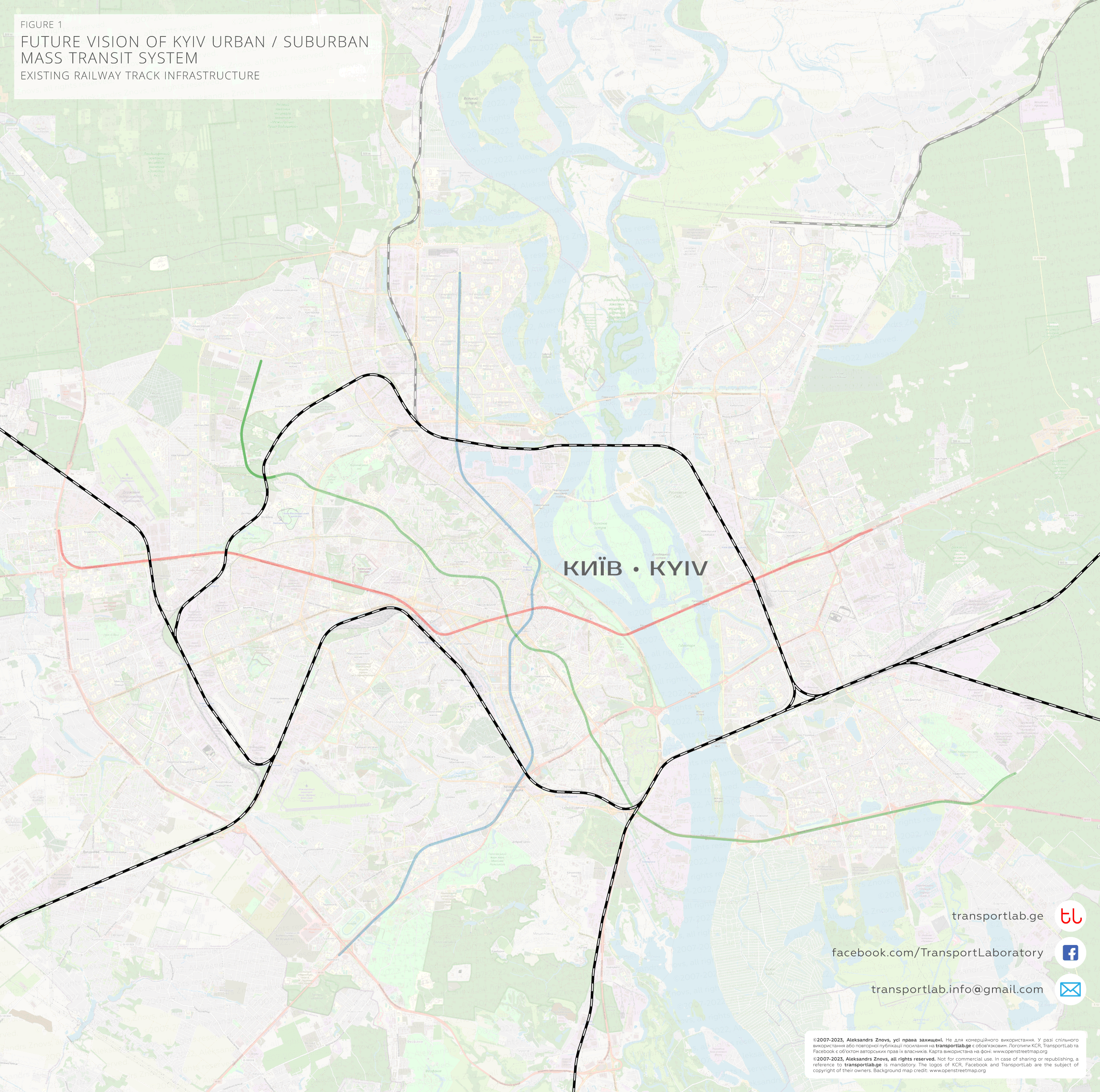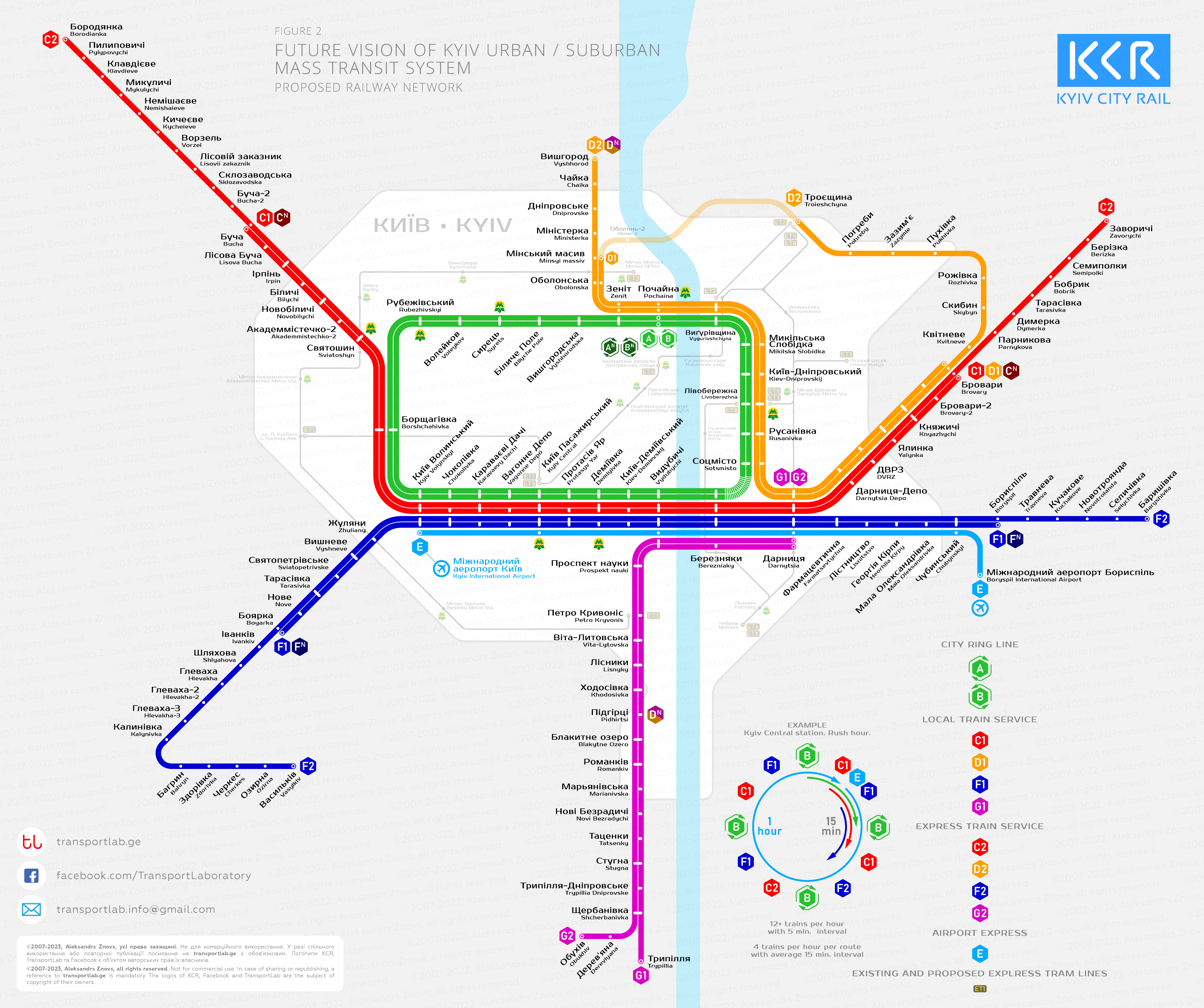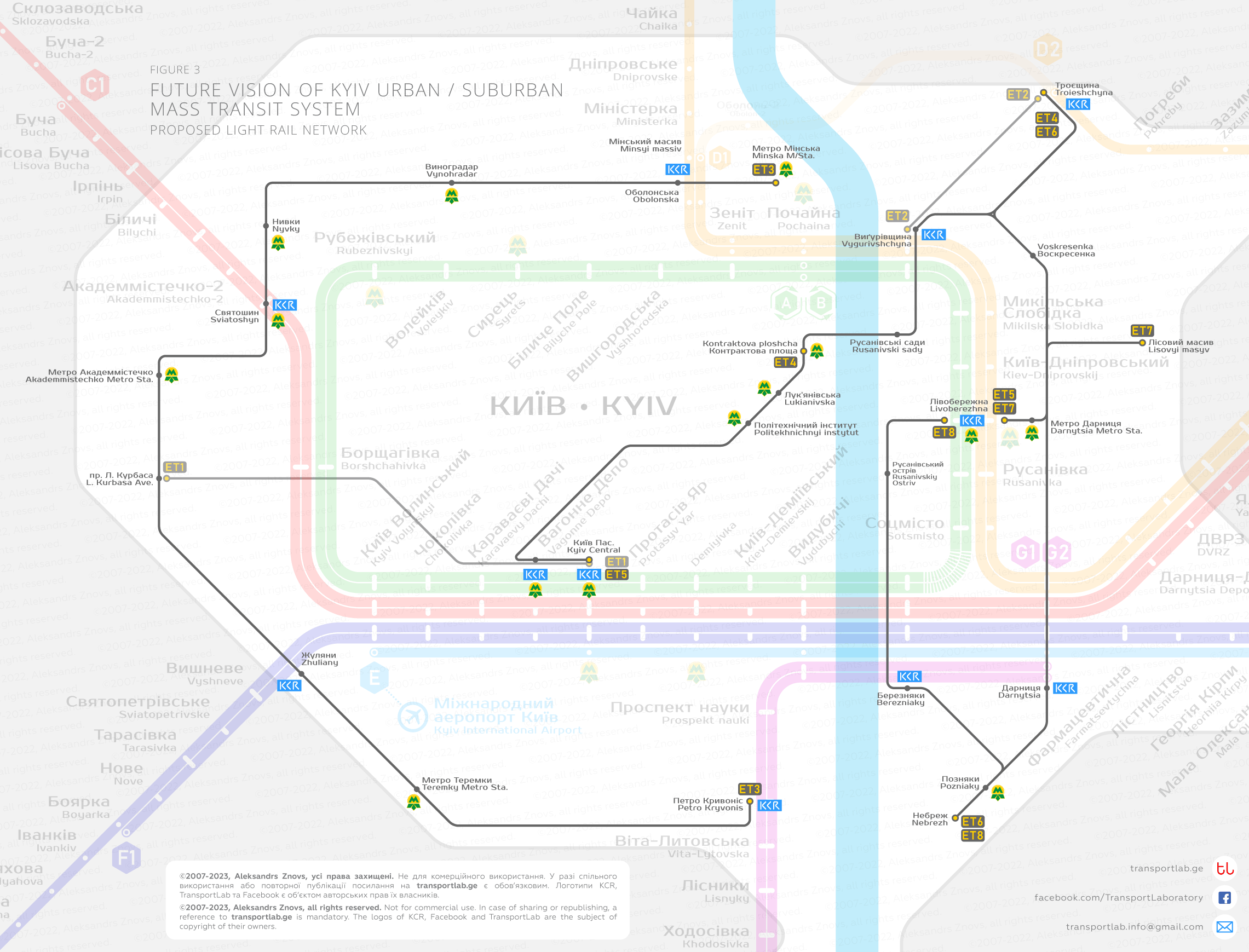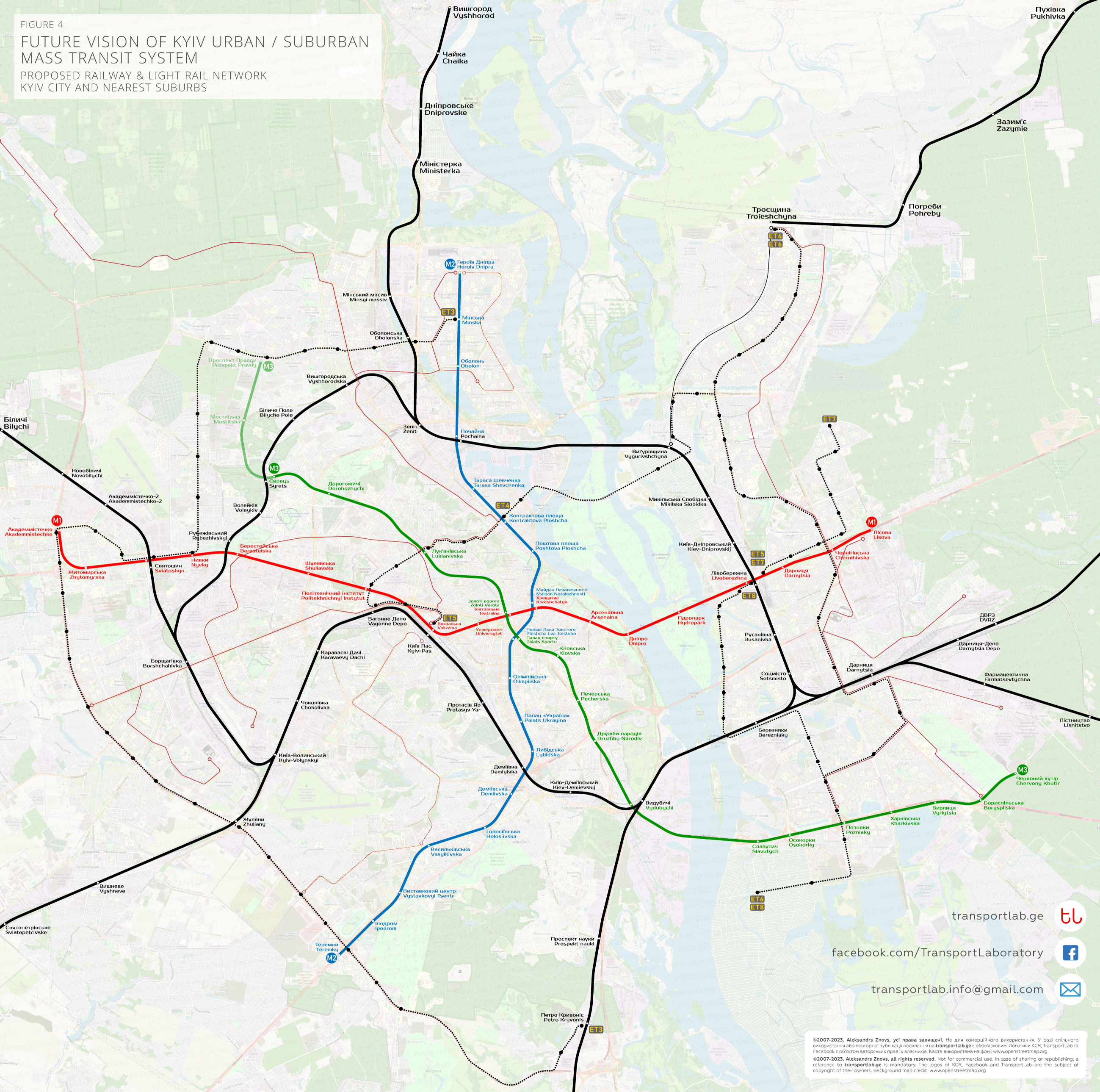Criticism
Despite the recent activity in the passenger transportation market of Ukraine, urban and regional transport in almost all parts of the country is still experiencing hard times. The capital of Ukraine is no exception here either. Passengers of the city of Kyiv are carried out by obsolete vehicles, the city suffers from a lack of trunk routes. It seems, city authorities forgot about types of transport, which can be effective both in the city and in the suburbs.
The city with a population of almost 3 million (4 million within the agglomeration) has three underground (Kyiv Metro) lines, a poorly functioning suburban train network, as well as a barely afloat city tram, which all the years of Ukraine’s independence have been purposefully destroyed. The Kyiv Metro network has not been developed for many years since the end of the Soviet era. This type of transport took on almost the entire load of mass transit in the urban area. It’s getting worse every single day as the metro is overloaded and losing its effectiveness as it cannot keep up with the growth trends of the population. This is such a sad picture.
Lukewarm springtime after the harsh winter
In fairness, it is worth mentioning that the government of Ukraine, together with the Ministry of Transportation of the country, presented a master plan for the development of rail transport, not forgetting the suburban train network of the capital. They are just plans and their full implementation is planned for a rather distant future, but the only thing that pleases me is that someone has finally taken up this, well, at least theoretically.
“Do we have a can opener?”
I decided to completely abstract from the official plans of the government and the mayor’s office of Kyiv and I wish to show my vision of a Kyiv transit system based on the existing railway infrastructure from the scratch.
Let’s take a look at what kind of infrastructure the city of Kyiv has and what can be offered. Figure 1 shows that the city must not be afraid of headaches of where and how to build new track infrastructure – everything is already there. This “everything” just needs to be put in order and someone must take control over this treasure and force it all to bring benefits to the population.
As you can see, the city already has a (double-track!) circle line, or rather almost a circle line. There are also platforms and a fairly high-quality electrified track infrastructure. For full efficiency, it is only necessary to build a section of about 900 m, which will close the ring in the area of the Darnitsa Railway Station, turning the partly circular link into a full-fledged circular line, and then take up the renovation of the platforms to meet modern quality and safety standards.
Passenger traffic is carried out in four radial directions, originating from the Circular Line: towards the cities of Brovary, Boryspil, Vasilkiv, Ipryn and Trypillya. Already on this base, an excellent transit system can be created. In addition, in the northern part of the city, there is a single-track section that begins from the Zenith Station and goes in the direction of Vishgorod, adjacent to the administrative boundaries of the capital. Also, almost completely within the city, there is one more industrial single-track line running from the city of Brovary to the thermal power plant, located near the densely populated district of Troyeshchina. Both of these sections can be converted for passenger traffic by creating another full-fledged line.
Having thought a little about how to put it all together, as well as adding additional platforms and stations that, if necessary, can be built soon, for my part, I can offer the following suburban transport system, which can be perfectly integrated into the municipal transport system, as it has quite a lot (51) of stations within the city, among which there are many transfer hubs for all three lines of the Kyiv Metro, not to mention the tram, trolleybus and bus routes. So it could look like this:
At first, I suggest using alphabetical and numeric values to designate the routes, where digit “1” denotes local trains with stops at all stations, but digit “2” stays for express service with fewer stops and trains moving further to the suburbs. Let’s look at each line for more details.
As already mentioned, Line A/B are 47 km long circular line that connects both banks of the city. For greater efficiency and to increase the flow of passengers, I offer to build the following additional platforms: Vagonne Depo, Chokolivka, Voleykiv, Biliche Pole, Sotsmisto and Demiivka.
Line C is likely to be the busiest as it connects Kyiv with densely populated satellite cities like Brovary, Ipryn and some other residential areas. There is a rather intense pendulum movements on this line on workdays. Line D (see below) could help to unload this line during peak hours in the Brovary direction.
The largest capital investments will be required for the conversion of industrial branches in Line D, which are not yet used for passenger traffic. One part of the line starts at the Zenit Station and passes by the Obolon and Minsky micro-districts, terminating in the town of Vyshgorod. The second part goes from Brovary Town to the densely populated area of Troyeschina, along the way touching the suburban villages of Pogrebi, Zazimie, Pukhivka, Rozhivka and Skybin. At the moment, as expected, there is not a single full-fledged passenger platform, both branches are not electrified. Undoubtedly, before the starting of construction, it is necessary to determine the expediency of investing in the development of this route.
Taking into account the existing plans for the construction of a large bypass road through the northern part of the capital along the Obolon Micro-district which possibly will cross the Dnieper River and then will pass by the northern part of the Troyeshchina Micro-district, it is worth considering the possibility of building the same bi-level bridge as in the case of Podilsky Bridge. Line D2 can (or light rail Line ET3 instead – read below) can be extended creating an additional transfer over the river and can be connected with the Blue Line of Kyiv Metro.
Line F passing through the central part of Kyiv will connect the capital with the city of Boryspil in the east and with Vasilkiv in the south. After Line C it will be the second busy route.
Line E is an already existing Airport Express route from the central railway station of Kyiv to Boryspil Airport, which can be extended to another airport located in the city – in Zhuliany District. Transit passengers will appreciate a convenient and fast transfer from one airport to another. If the transit flow will increase significantly, there will be possible to build a section 1,5 km between the Kyiv-Volinsky Station and Kyiv City (Zhuliany) Airport, eliminating the bus shuttle.
And finally, the last, less busy route is Line G, which can be extended from Tripillya to Obukhiv by converting the existing 3 km industrial line into a passenger one.
Rolling stock
According to transport ergonomics experts, within city borders, the best choice would be single-deck trains with more than two wide doors per side of the coach. Thus, the circle line and local sections of radial lines (C1, D1/D2, F1, G1) can be served by single-deck trains. Whereas the express service (C2, F2, G2) could be served by double-deck rolling stock, which is being used mainly for regional or interregional traffic.
Hey, where are our bonuses?!
Ah, oookay, here we are. In fact, Kyiv in addition to a small city tram network has 2 light rail lines – one on each bank. Each new metro line always is a huge investment, besides, it takes a long time to build and the construction process usually is accompanied by many unforeseen factors which make this complicated construction process even more complicated. Light rail is the solution!
So, in order to divert the passenger flow from the centre of the city, the consideration to construct a large semi-circular light-rail line running along the bypass road is the way to start. As I mentioned above, it can be extended to the right bank. Let’s name this Line ET3 (ET1 and ET2 are already existing light rail lines). On the image below you can see all transfer stations this line could have:
Further. The Line ET4 could use the new still unfinished bridge, which is designed for two-level traffic – road vehicles and rail. In this case, there will be a great opportunity to connect the city centre with the densely populated micro-district Troyeshchina. Presumably, this line should not duplicate the already built high-speed tram line (ET2) but would run parallelly and cover the other Troyeshchyna quarters. In the centre of the capital, the line could start at the metro station Kontraktova Ploshcha.
Line ET5 would start from the central railway station and, partially using the existing infrastructure of the city tram and partially duplicating the Line ET4, would go through the Voskresenka Micro-district to the suburban rail station Livoberezhna.
Instead of the once planned left-bank line of the metro, Line ET6 would serve as the main left-bank radial line connecting Troyeshchina in the north with the Poznyaki micro-district in the south.
The short ET7 Line would serve as a shuttle, taking the inhabitants of the Lisovyi Massiv to the Darnitsa Metro Station and Livoberizhna Railway Station. Line ET8 would perform a similar function serving the Bereznyaki Micro-district and the coastal part of the Rusanivka. Let’s take a look at real map with all rail lines in frames of Kyiv City:
Night service
If the residents of the capital, at least on weekends have an interest in night traffic, it can be organized on the principle of duplicating daytime local lines – let’s look at Figure 2 again. Namely, the Circle Line A/B, Line C, Line G, the section of Line D to Vyshgorod and the section of Line F to Pidhirtsi can be combined through the left bank to avoid duplicating Brovary direction. Line E already operates around the clock with an average interval of 1 hour by default.
Since the Kyiv Metro does not work at night, the suburban train network can compensate for this shortcoming. Well, if the demand for night transportation, or at least for additional trains after midnight will grow, the option to introduce night service during the workdays can also be considered. In my opinion, at least the last commuter train must leave any transfer station with the city metro only after the arrival of the last metro train. If necessary, light rail lines such as ET3, ET4 and ET5 can also be connected to night traffic. However, it is worth remembering that freight trains should have priority during the nighttime to unload the tight daytime schedule.
Afterword
Leaving aside the possibility of developing metro or tram lines, this is essentially all that can be offered at the moment. Having created a fairly tight traffic schedule, monitoring the observance of intervals, creating a high-quality accessible to all residents infrastructure, using modern rolling stock and not forgetting about integration into the municipal ticket fare system, it will be enough for Kyiv and its suburbs. One can only hope that the city administration will take matters into their own hands and be able to negotiate with neighbouring municipalities, the national railway operator Ukrzaliznytsya and the municipal transport company Kyivpastrans. The fight against all-consuming corruption and unprofessionalism at all levels of local and state government will help to achieve the target too. I believe Kyiv City will be able to forget about the dark, chilling years of the post-Soviet period and become a worthy home to its inhabitants.
Please visit and like my page on Facebook where you can contact me in case of any question or claim mistakes found on my network maps. Hereby, you can follow me as well on Twitter to stay informed. Thanks.
Title image credit: Sergii Vozniuk













